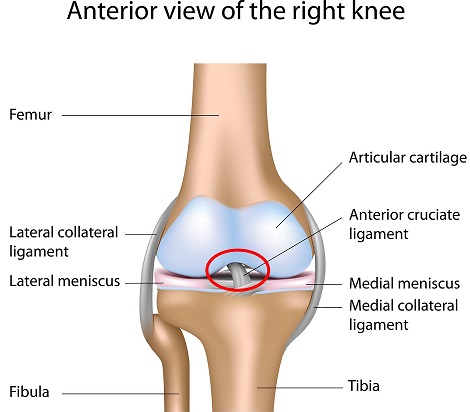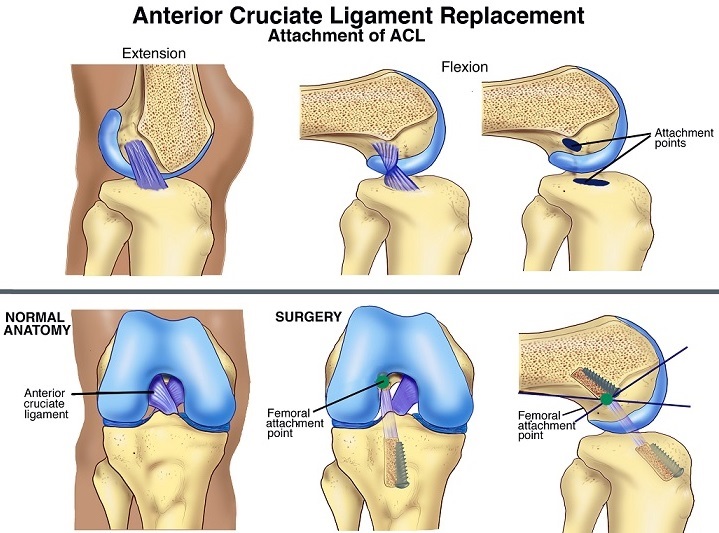ACL Surgery Recovery Timeline
Nov 06, 2015
A torn anterior cruciate ligament, or ACL, is an injury that is pretty common in sports. It doesn't usually happen in a contact sports situation but more typically is the result of a player turning the wrong way or changing directions haphazardly. It does happen in contact while playing football.
Though the recovery time is much shorter than it was before, it can still take months before an individual can get back to activities and the ACL surgery recovery timeline varies a lot.

How Is ACL Surgery Done?
The surgery to repair a torn ACL requires reconstructing or repairing the ligament.
- When replacing the ligament, a graft is used to reconstruct it. Most of the grafts can be taken from your own body using the patellar tendon, which comes from your kneecap, or one that comes from the hamstrings. Using allograft tissue from someone who is deceased is another option.
- If there is a separation of the bone and the ligament, it is more likely to perform surgery to repair the ACL. The procedure consists of reattaching the bone fragment to the bone.
There are two options when performing surgery: one is arthroscopic surgery which is to make several small cuts in the knee in order to insert surgical instruments through the incisions, or open surgery where a large cut is made in the knee.

ACL Surgery Recovery Timeline
One to Two Weeks After Surgery
- Pain and swelling: The swelling that comes with just about any surgery can be painful. After the surgery you can expect joints to be stiff and a decrease in the contractile force of some muscles. The best thing to do is to keep movement to a minimum, elevate the area, incorporate compression, and ice down the area in the beginning.
- Soft tissue: You will have to wait until the soft tissue begins to heal before you can begin starting any therapy or range of motion exercises.In order to ease the stiffness of the kneecap and surrounding skin, you might want to add a regular massage to your therapy.
- Knee: You should be able to stretch your leg straight out by the second week. If that is not possible you may want to get in touch with your doctor.You may not be able to put your entire weight down on the knee right away but you don't have to push it, you will probably have the use of a brace until you are ready.
- Quadriceps: Because of the surgery, your quadriceps muscles may be put on hold. As soon as you are able, it would be to your advantage to engage them again.
- Crutches: You can expect to get off of your crutches within a week or two after surgery.
- Car driving: Depending on what type of car you drive, stick shift or automatic, you probably won't be driving for one to four weeks.
One to Two Months
The period between one to two months is a crucial point during the ACL surgery recovery timeline as some simple movements such as climbing stairs and walking without crutches start returning.
- Climbing: It may take you about a month before you can climb a set of stairs again.
- Bending your knee may take a bit more time after surgery.
- Walking normally without crutches could take anywhere from 4 to 6 weeks.
- Recovering graft: After the surgery you can expect it to take from 4 to 6 weeks for the graft to become fixed to the bones. Don't worry about the screws, they will dissolve after a while. The new ACL will begin to regain blood flow in that area and your sense of balance will return.
- Exercising knee valgus: In order to control the knee valgus, which is what creates the stress in the ACL to begin with, it is advised to incorporate exercises like Sumo Deadlifts and X-Band Walks into your routine.
More Than Two Months
- Jogging: If you are anxious to get back to jogging, you can try doing it in the water after the first couple of months. The water is able to protect your knees from the impact yet still give you the benefit of jogging. You might have to wait until about three months after the surgery before you can begin to jog on land again.
- Sprinting: In order to be able to sprint again you must be able to run without limping. Once the strength in the side of your leg that was operated on returns, you may be able to sprint while wearing a brace but that could be from 6 to 9 months after your surgery.
- Movements returning: Most of your regular movements will begin to return in about four months. Exercises that you performed before your surgery may take a little longer depending on how you are healing. You may be able to jump rope at three to six months after the surgery while other activities that involve your repaired knee could take up to nine months. Full and partial lunges, squats and other strenuous activities could take from four to six weeks. It's not uncommon for it to take from four to six months to be able to resume high speed deceleration again.
While you may be healing well, you need your strength to return, your core control to be in place and your stability to be back before taking on anything too strenuous.
Possible Complications You May Experience
Surgery of the ACL is usually a safe procedure. However, as with any surgery, there could be complications that could come about after the procedure or during the ACL surgery recovery timeline or rehabilitation process. Some complications could include:
- Typical complications of a surgery such as an infection in the incisions, blood clots in the leg, problems with the anesthesia, or numbness around the scar.
- You may experience problems with the screws that have been put into place to graft the bones in the leg.
- The inability to straighten out the operated on leg as far as the other leg. Wait until you undergo rehab before jumping the gun.
- You may experience pain when kneeling at the point where the graft was removed from the patellar tendon or the tibia.
- The kneecap may grate against the bottom end of the thighbone causing it to be painful and limit your progress.
- If you find that you have reinjured the graft you may have to have another surgery to repair it. It may not be as successful a procedure as the first one.
 New Health Guide
New Health Guide

